About the blog: Basgo Monastery is a beautiful and important place to visit in Ladakh. Located about 40 km from Leh town on the Srinagar-Leh Highway, you can see the ruins of Basgo Gompa and fort from a distance. Basgo has an interesting history and was once the capital of the Namgyal Dynasty in Ladakh. Read this travel blog to know about the history and architecture of Basgo Monastery, temple complex and Basgo Fort along with relevant information.
The journey on the Leh-Srinagar Highway is a beautiful one. There seems to be something of interest around every corner on the road. However, there was one place that had always piqued my interest during our previous trips to Ladakh. It looked like a ruined citadel. It could have been a monastery as well. The structure blended with the brown cliffs on which it was perched. Only the white colours stood out strikingly, framed against the blue skies and surrounded by the dramatic landscapes that Ladakh is so known for. The first time I saw Basgo Monastery or Basgo Fort, I was captivated by it. Unfortunately, time was a constraint at that time and we could not explore the place. However, during our last visit to Ladakh, we made it a point to visit the Basgo Monastery.

So, there I was standing in front of the grand structure and thinking of citadels and forts, of erstwhile kingdoms and the enigmatic silk route.
Visiting Basgo Monastery
Exploring Sham Valley had been an incredible experience thus far. We had started in the morning and travelled all the way to Mangyu Monastery. After exploring this lesser-known place in Ladakh, we went on to visit Saspol Caves and Likir Monastery. Not only were we mesmerised by our destinations, the journey was equally fascinating. Travelling on these roads of Ladakh was an equally spiritual experience along with exploring the monasteries and cave temples.

Reaching Basgo Monastery
It was already late afternoon when we reached Basgo. The Basgo monastery and the fort loomed like an enigma in front of us. The structure perched on the hill looked intimidating. We drove through the winding roads in the middle of cliffs towards Basgo Gompa. After traversing a couple of hairpin bends, we finally reached our destination. As we reached, we found out that renovation work was going on there. Where once a road used to lead towards the Basgo Monastery was totally dug out. To reach, we had to either cross the dugouts and potholes or go down to the village and climb up again using the other route.

It was already late and we were a bit tired as well. So we decided to be a little adventurous and carried on forward. We jumped over the trench, crossed the barriers, clambered up the muddy path to finally reach the monastery and fort complex. It was definitely worth the trouble.
Once we were at the complex, it felt as if we had travelled back in time. The entire structure looked imposing and grand. Even when the Basgo Palace looked crumbling, it held an aura of mystery and resilience. After all, it was, once upon a time, an important part of the Ladakhi Dynasty.
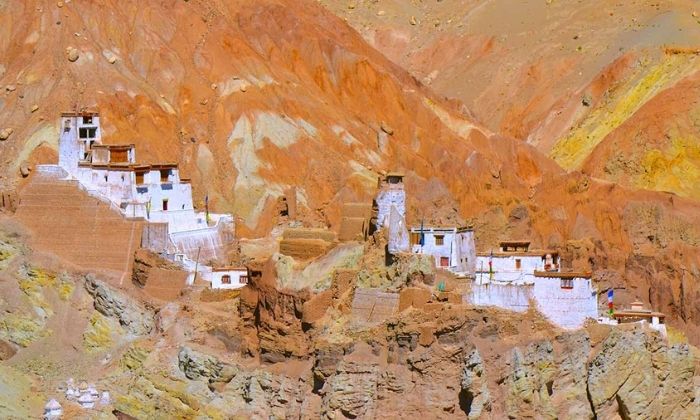
History of Basgo Monastery & Fort
Historically, Basgo was strategically located on the trade route at the junction of upper and lower Ladakh and had access to both Kashmir and the Silk Route. It used to be the final staging point of the caravans and travellers. Most of the earlier travel accounts of Basgo acknowledge its importance.
Basgo had gained political importance at the end of 15th century with the establishment of the Second Ladakhi Dynasty. The Ladakh Chronicles is a historical work that covers the history of Ladakh and mentions Basgo quite a number of times.

The Story of Basgo
Raspa Bum was the ruler of Ladakh having his palace at Shey. He was reputed to be a great builder and supported the constructions of religious institutions. In the first quarter of the fifteenth century, he received Basgo as a part of a political settlement with his brother Raspa Bumde. As per the Chronicles, Raspa Bumde was also a great builder.
Both the brothers brought Basgo into the forefront of the political space in Ladakh. The Chronicles also mention that Raspa Bumde constructed a grand temple, which is believed to be the Chamba Lhakhang at Basgo Monastery.
The geographical location of Basgo proved to be an ideal place for a position of power. While Raspa Bum brought Basgo into the limelight, it was his grandson Bhagan, who contributed to the development of Basgo as a centre of power and trade. Bhagan’s accession to the throne of Ladakh marked the beginning of the second Ladakhi Dynasty. With the shift in the seat of power, construction activity around Basgo increased.
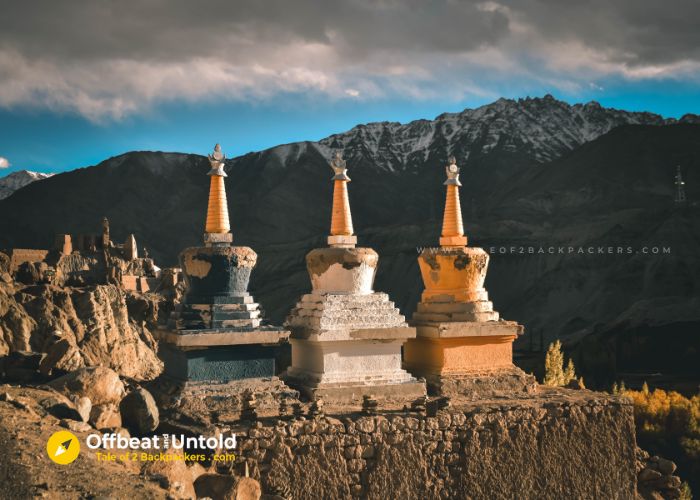
Namgyal Dynasty
Bhagan established the Namgyal Dynasty in 1460 after forming an alliance with the people of Leh. He took the title of “Namgyal” which means victorious.
Owing to its strategic location, Ladakh was constantly under the radar of the Muslim rulers of central Asia. King Tashi Namgyal (1555-1575 AD) managed to counteract the foreign attacks successfully. The next ruler, Tsewang Namgyal was one of Ladakh’s most prominent rulers who extended his kingdom as far as Nepal.
Tsewang Namgyal was succeeded by Jamyang Namgyal. He faced several rebellions from the local chieftains. Finally, he was defeated by Ali Mir, the Chief of Skardo. Jamyang Namgyal was then taken to Skardo in confinement. While in captivity, he fell in love with Princess Gyal Khatun, the daughter of Ali Mir and later married her. Because of the alliance, he was able to return back to Ladakh. It is often believed that Gyal Khatun was the main patron of the Cham Chung Temple.
After the death of Namgyal, Gyal Khatun took active part in the running of the kingdom till her son Sengge Namgyal ascended the throne. Sengge was one of the successful military rulers of Basgo who was able to restore the kingdom to its former glory. He extended his kingdom to Guge, Purang, Zanskar and Spiti. He was also responsible for the construction of several monasteries, the famous ones being Hemis Monastery and Hanle Monastery. Most of the constructions of Basgo including the temple complex and the fort were carried out during the period of Jamyang Namgyal and Sengee Namgyal. Senge Namgyal also commissioned the two-storey high statue of the Maitreya in the Serzang Temple.
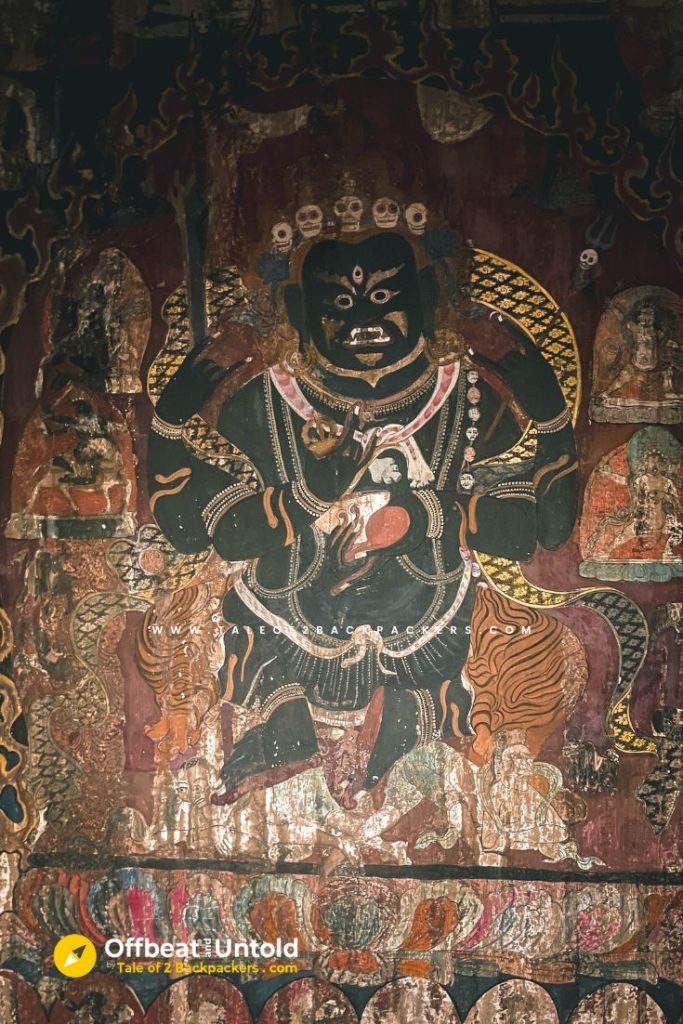
Reign of Sengge Namgyal
However, Sengge Namgyal later shifted his capital to Leh, and Basgo gradually lost its former glory and political position. Finally with the arrival of Dogra General Zorawar Singh from Kashmir in 1834, Basgo totally lost its sheen. The army of General Zorawar Singh captured and pillaged Basgo fort leading to its decline. Now, only three temples survive along with several ruins bearing a testimony to 400 years of Ladakhi history.

Basgo Palace
Basgo Monastery consists of the ruins of Basgo Fort (Khar), ruins of the royal palace and its quarters and the temples. There are 3 temples that have been restored – all 2 worth visiting.
- Chamba Temple or Chamba Lhakhang
- Serzang Temple
- Cham Chung Temple
Unfortunately for us, when we visited the Basgo complex, the main temples of Chamba Lhakhang and Serzang Temple were closed because of renovation work. We were quite disappointed. We requested the monk who was present there, but nothing could be done. Usually, if the monk had the key, he would have opened it for us. It happened in many other places. But here, the caretaker had already left with the keys. It was also late and it was not possible for him to go get the keys. Disappointed, but not disheartened, we went around to explore the rest of the place.
Architecture of the Basgo Fort
The Basgo Fort is now in total ruins. Once upon a time, in its glorious days, Basgo Fort was a self-sufficient township with the capacity to withhold a siege almost indefinitely. This was proven during the 1680s, when the Ladakhi forces at Basgo Fort held the invading Tibetan army for 3 long years!

There are a series of watchtowers standing at strategically highest points of the landscape. There was also a wall all around the perimeter of the Basgo fort. Only some sections of the walls are standing today.
The eastern part of the fort complex has the ruins of the royal palace and it was further isolated by another wall. The palace was multi-storeyed. The fort also had granaries and a perennial water source in the mountains.
Very little remains of both the royal palace and Basgo Fort. We could see the empty walls, falling staircases and rubble around the royal palace. The brown structures seem to be falling down. But even in this crumbling state, the Basgo Fort looked formidable. The geography of the place definitely plays an important part for the invincible and impressive look of the fort.
Temples of Basgo Monastery
The structures that have survived and have been renovated are the three Maitreya Temples. The first temple is situated to the right of the open courtyard and is the Serzang Temple. Chamba Lhakhang stands above and can be reached by a flight of steps. And the Cham Chung Temple lies at a corner of the courtyard.
Unable to visit the Chamba Lhakhang and the Serzang Temple, we headed towards the backside of the courtyard. Fortunately, the Cham Chung Temple was open and we went to explore the small temple.
Cham Chung Temple

Cham Chung Temple is a small temple located at a corner of the open terrace. The exterior of the temple resembles a Balti or a Central Asian Mosque. It is because of the architecture of the temple, it is believed that Cham Chung Temple was commissioned by the Balti princess, Gyal Khatun, wife of Jamyang Namgyal. The temple was originally a Mosque, a place of prayer for the princess. Legend says that Gyal Khatun later adopted the Buddhist faith and the mosque was converted into a monastery.

The door was small and we had to duck our heads to enter the temple. As our eyes got adjusted to the darkness, we saw an image of the Maitreya Buddha. This statue has been restored by local artists. The walls of the temple had frescos of various Tantric deities. We could identify the images of Yamantaka and Mahakala.
The other two temples are pretty important and impressive to not find a mention here, even though we did not personally visit them.

Chamba Lhakhang
Chamba Lhakhang is the largest temple in Basgo Monastery complex. Standing above the ruined palace, it can be reached by a flight of steps. Inside the temple, is a colossal statue of Maitreya Buddha surrounded by colourful murals. Even the ceiling is decorated.
Chamba Lhakhang was commissioned by Tashi Namgyal. The paintings were made in the sixteenth century under the patronage of Tsewang Namgyal.

The seated Maitreya Buddha inside the Chamba Lhakhang is simply gigantic. It is almost 9 m tall. I am sure it would be an extremely stunning sight.
Serzang Temple
The Serzang Temple was built in 1622 by King Sengge Namgyal in memory of his father Jamyang Namgyal. King Jamyang Namgya had invited Mahasiddha Stagsan Raspa to his kingdom. However, before the Mahasiddha could visit, the king lost his life. However, Stagsan Raspa visited Basgo and under his guidance and blessings, Sengge Namgyal and Gyal Khatum commissioned the building of Serzang Temple.

It houses a huge gold-plated copper statue of the Maitreya Buddha. And it is an impressive sight. On the walls of the temple are stacked Tibetan Buddhist scriptures. On the left wall, the Kangyur (Buddha’s sayings) are kept and on the left, the Tangyur (commentary and interpretation) on the right wall. The writings are mostly inscribed in copper and gold. Infact, Serzang is derived from the Tibetan words “ser” meaning gold and “zang” meaning copper.

We were sad as we could not visit the Chamba Lhakhang and the Serzang Temple. But whatever else we saw was beyond our expectations. The entire Basgo monastery complex was simply looking stunning against the backdrop of the setting sun.
We explored the ruins and started our hike downhill towards the village. There are a number of chortens scattered around. It was already getting dark by the time we were leaving the Basgo Monastery complex. And we reached the main road to our car, it was already dark. After a very satisfying day of exploring Sham Valley, we were on our way back to Leh.

Preserving Basgo Monastery
In 2000, the World Monuments Fund nominated Basgo Palace in its list of 100 most endangered sites. The temples were again included on the World Monuments Watch in 2002. With the additional help of ASI, Namgyal Institute for Research of Ladakhi Art and Culture, conservation efforts began at Basgo Monastery.
Though much of the Basgo Gompa complex had deteriorated over time, the three temples stood the ravages of time and were given preference during restoration. The Maitreya Temples of the Basgo Monastery are one of the oldest surviving religious structures of their kind dedicated to the Future Buddha.

How to reach Basgo Monastery?
Basgo is an agrarian village located about 40 km from Leh town. You can see the ruins of Basgo Gompa from a distance when you drive through the Srinagar-Leh Highway. The monastery is perched on a hill at Basgo.
You can visit Basgo Monastery as a day trip from Le. You can hire a car from Leh to visit the monastery. This can be done as a day trip along with Alchi and Likir Monastery trip.

Can we stay at Basgo?
Basgo village now has a few homestays where you can stay. Otherwise, you can stay at Leh, which is only 40 km from Basgo.
In Conclusion
Ladakh is actually a treasure trove of Buddhist art and culture. Basgo Monastery and the fort are one of the major pillars of Ladakhi history. And today, one of the important attractions in your Ladakh trip. To all those who wish to visit Basgo, we just request you to treat the place with respect and care. After all, losing heritage is like losing a part of yourself.
Hope you liked the post. If you found this useful, please share this with your family, friends and neighbours.
Pin it for a later read!




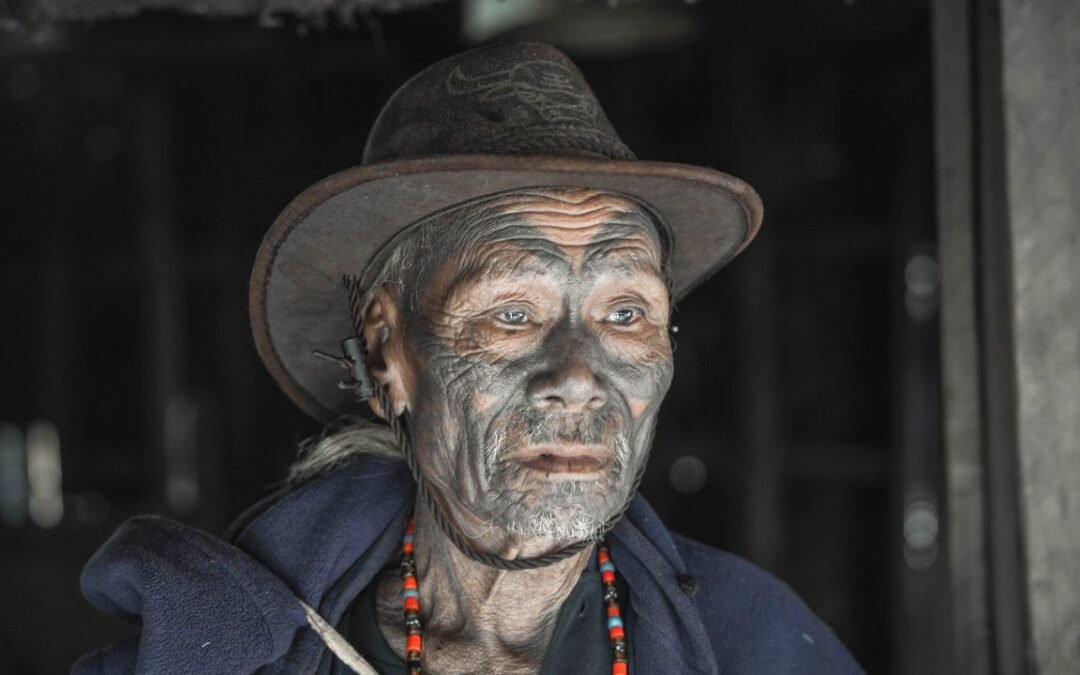
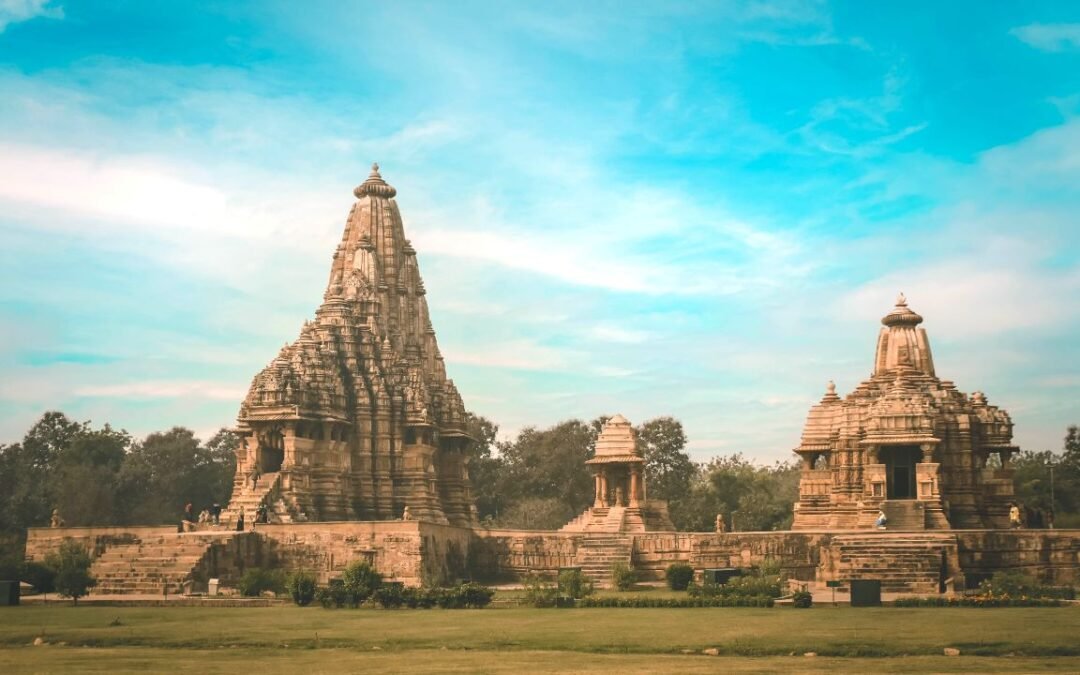

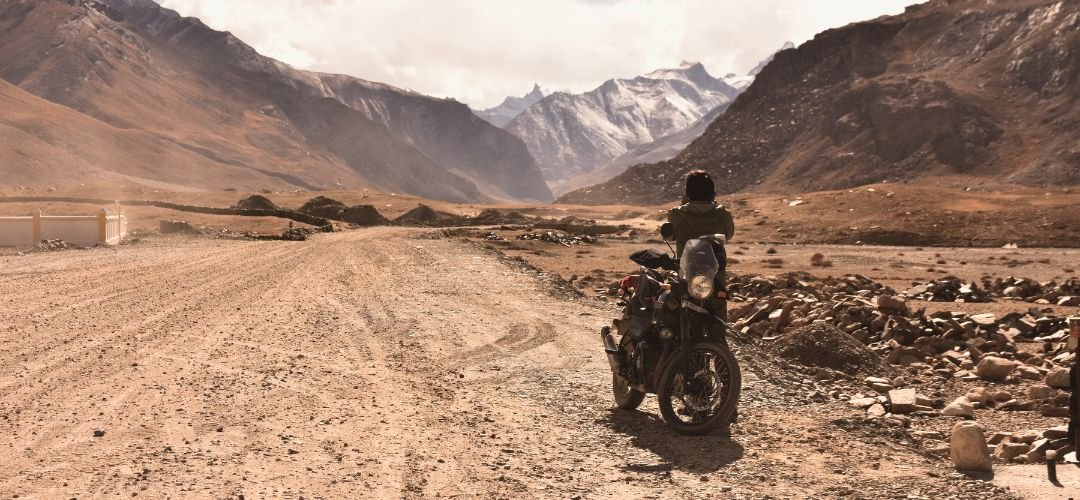
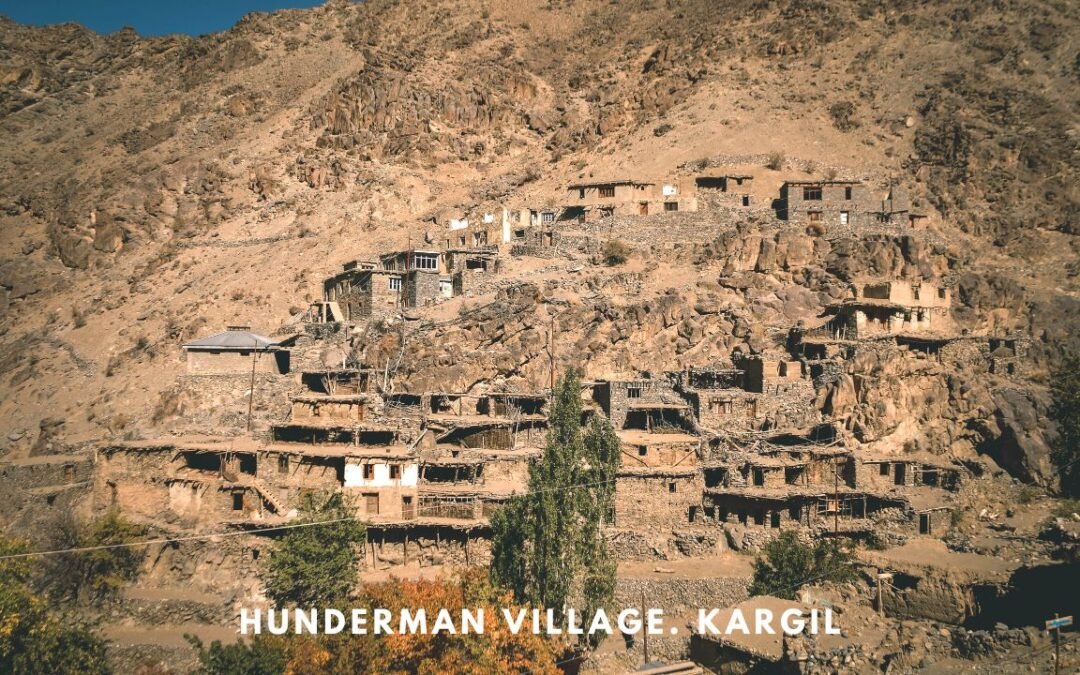
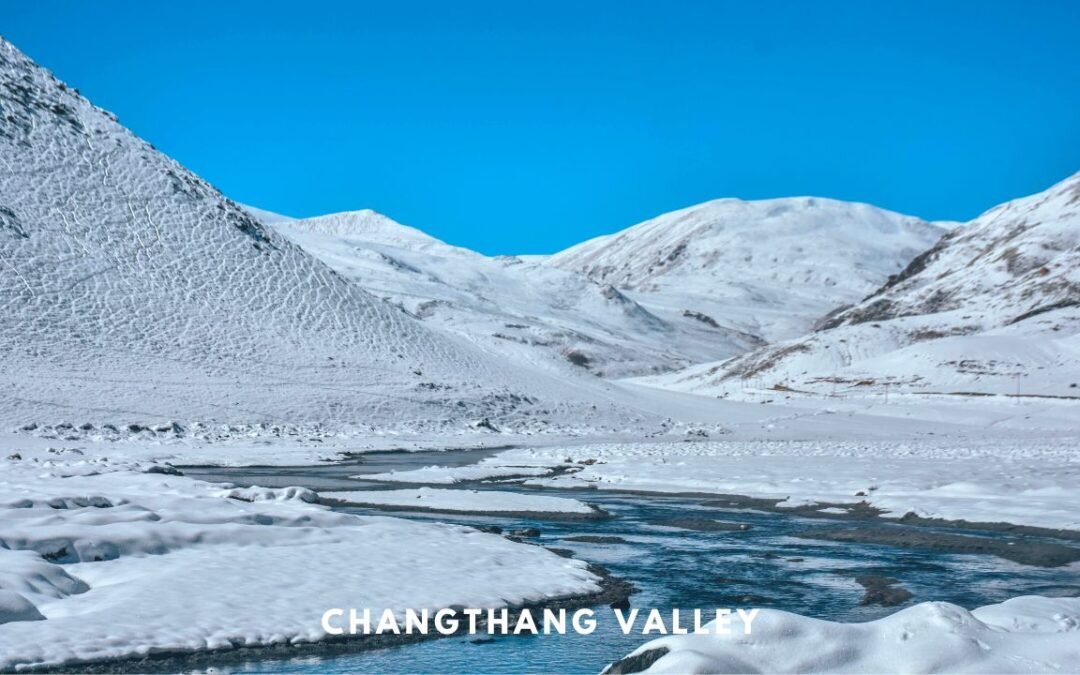
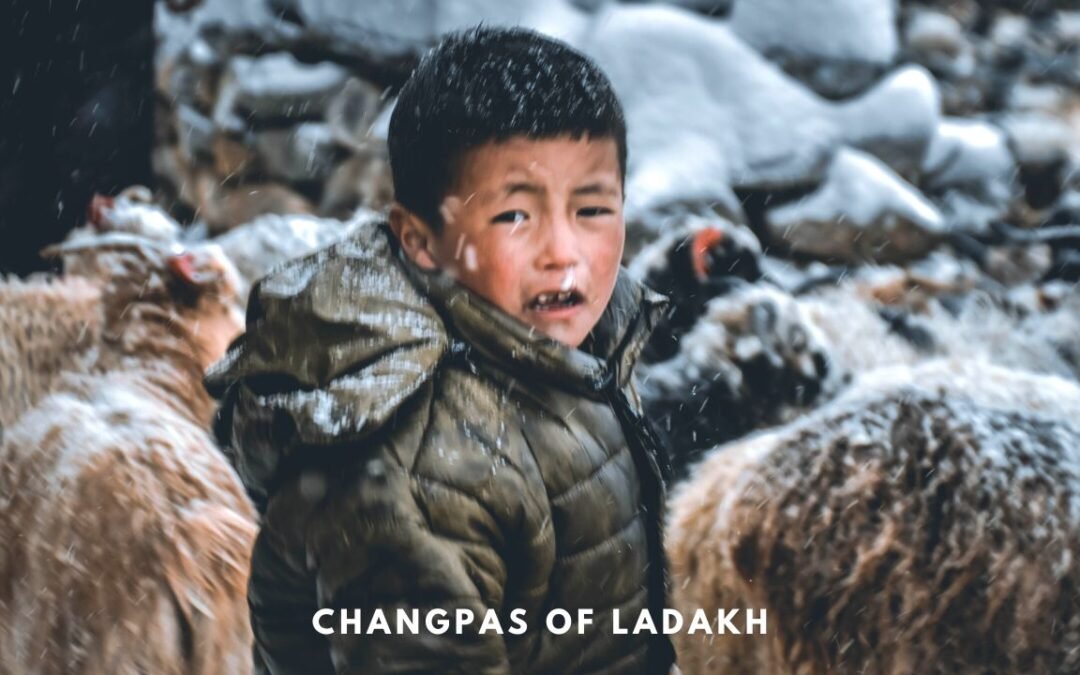

0 Comments